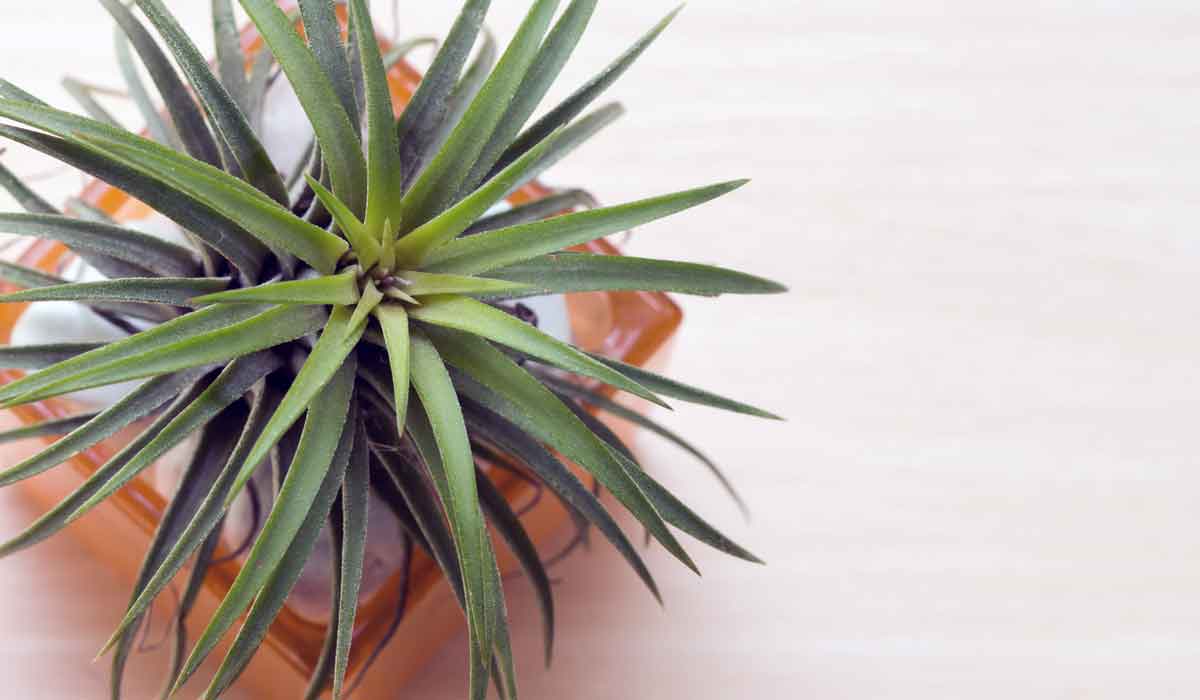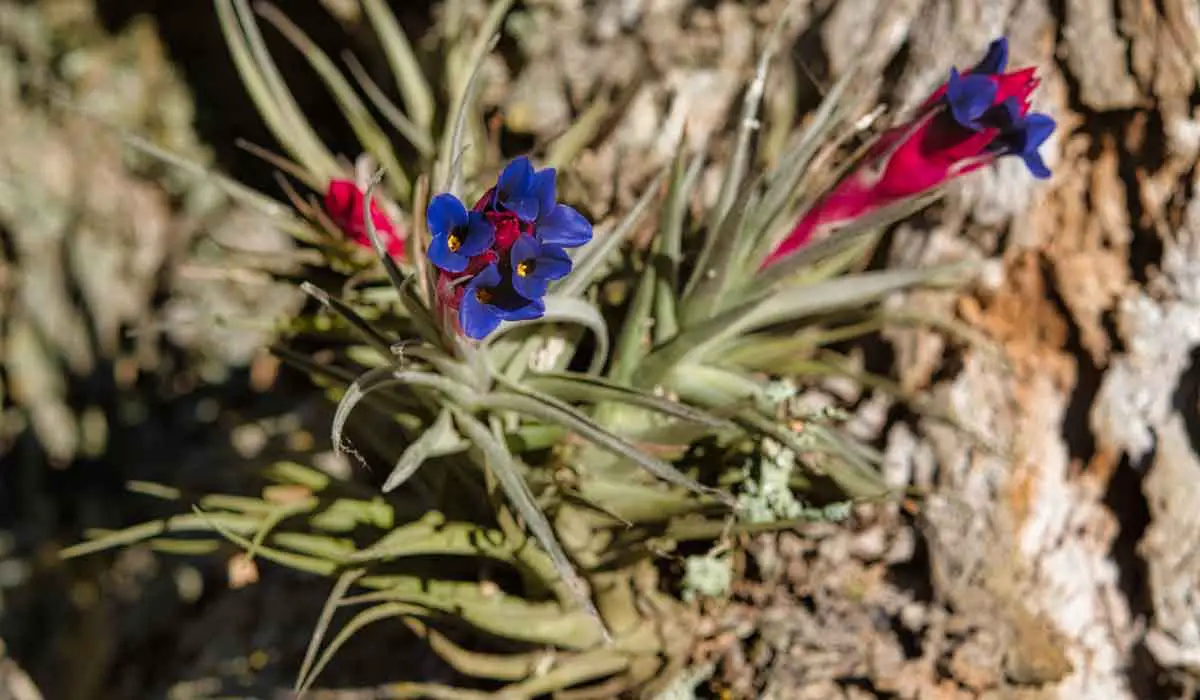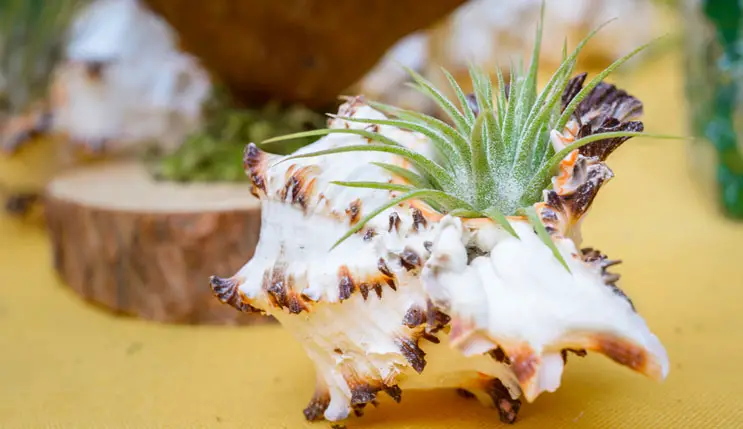Air Plants In Bathrooms: Good or Bad Idea?

This post follows our research editorial guidelines.

With curling tentacles and scaly leaves, the unique shape of an air plant (Tillandsias) can make them seem more like a sea creature than a plant. They’d be a perfect plant to decorate any well appointed bathroom – but is that a good place for them? Does it check the boxes for these humidity-loving tropical favorites?

Table of Contents
Can Air Plants Survive In The Bathroom?
Provided there is enough light and enough ventilation, air plants will thrive in the humid air of a bathroom. Mesic Tillandsias will especially enjoy the extra humidity found in most bathrooms making them the perfect addition to a fogged up windowsill.
Watering Air Plants
Air plants don’t have roots, so it’s often challenging to work out how best to water them. How do you water air plants when there’s nowhere to pour the water?
Tillandsias have a few traits that help them stay hydrated without the need for roots. Their leaves are covered in complex hair like structures called trichomes. These allow water in the air to condense on the plant, to be absorbed through the pores of the leaf.
Air plants growing in steamy bathrooms absorb moisture from the air in this way, especially if there’s a lot of warm showers or baths happening at your home. Those fogged-up mirrors show just how much water there is in the air for your plant to drink.
But it’s still a good idea to give your Tillandsia a top-up every now and then, especially in the summer when the temperature rises and folks have fewer hot showers. One option is to mist them gently with distilled or filtered water in a plant mister. I also suggest that you give your Tillandsia a bath of its own from time to time – we don’t want it feeling left out! Soaking an air plant in a dish of clean water for fifteen minutes or so once a week is excellent insurance against dehydration.
Types Of Air Plants That Do Well In Bathrooms And Showers
Key to getting the best from your new bathroom beauty is choosing the right plant for the job. Tillandsias hail from the rainforests and arid highlands of Central America. They can be roughly divided into two groups – the xeric and the mesic.
Xeric air plants are high altitude desert specialists, hailing from the cloud forests and highlands. They are fuzzy, often to the point of being silvery or white. This fuzz helps them draw moisture from their environment, giving them an edge in their desert homes.
Mesic air plants on the other hand are from wetter, more humid forests in the lowlands. They affix themselves to trees and other high structures, thriving in the dappled light of the jungles. They are greener, with less fuzz than their xeric cousins.
While all types of Tillandsias will do just fine in a bathroom if the light is good, mesic air plants will especially love the extra warmth and humidity. They include:
Tillandsia bulbosa

This mesic air plant is an excellent choice for a humid bathroom. It’s a compact plant, with long thin green leaves that are almost like gripping tentacles. They look more like a sea creature than a plant!
Tillandsia punctulata

Also known as Mexican Black Torch, this sleek green air plant is an elegant choice. Its thin whiskery leaves grow in wild profusion, like a sea urchin. It takes its common name from its vibrant red flowers.
Tillandsia capitata

Tillandsia capitata is better known as the Head-Seeking Air Plant, a slightly foreboding name for such a charismatic plant. It features slick green leaves that have an almost casual posture to them, a relaxing choice for a more spa-themed bathroom.
Tillandsia aeranthos

Also known as the Air-Flowered Air Plant, these grow in tight spiky balls with silvery-green leaves. They often produce bright pink flowers as part of their life cycle, adding a pop of color.
Tillandsia ionantha

More commonly know as the Sky Plant, this dainty delight stays under seven inches long and comes in a variety of different colors, shapes and forms. Keep an eye out for the ‘Peach’ cultivar, a sweet little pink plant no more than an inch or two high, and the fiery red ‘Fuego’ with its characteristic scarlet leaves.
While technically a xeric and less fond of humid air, the T. ionantha has been cultivated to thrive in just about any indoor environment, so it makes for an excellent all rounder.

Can Air Plants Survive In Low Light?
Regrettably, if your bathroom is too dark, your air plant will struggle. Even the mesic Tillandsia enjoy as much bright, diffuse sunlight as possible. Too little and they will struggle to survive. A bathroom with a skylight is ideal, or one with a good southern or south eastern aspect.
But don’t despair! If you want a jungle garden in your closed in bathroom, consider a grow light. These are broad spectrum lights that simulate natural sunlight. A simple grow light bulb is a great option for a small half-bath, and for a more palatial northern facing room you’d do well for a stand alone unit. Air plants typically last for 2 years so setting the right growing conditions will make the most out of the time your have before they flower.
4 Bathroom Air Plant Decorator Ideas
Decorating with air plants is one of the most fun things about them. They’re such simple plants to style, with a wide range of options available.
“Because air plants can grow and anchor themselves to surfaces other than soil, they can be grown on or in a wide selection of surfaces. They can be attached to bark, shells, rocks, or placed in a shallow dish.” writes Barbara H. Smith, HGIC Horticulture Extension Agent for Clemson University. “They also may be hung on fishing line or thin wire from the ceiling or a rod to create an interesting display.”
Here’s a few of my favorite options for displaying air plants in bathrooms.
Vase
There’s really no easier thing that just popping an air plant in a small vase. They last longer than flowers and a vase will keep them upright and radiant. Dainty vases also don’t take up much space and can lift a lovely Tillandsia up to a level where its beauty won’t be overlooked.
Terrarium
A glass walled terrarium is a popular decorator choice right now. The sharp geometric edges of an angled terrarium or the smooth curves of a open glass bubble contrasts wonderfully with the exuberant, often wild looking leaves of the air plant.
I like to pop a handful of pebbles at the bottom to keep them upright. I’ve also seen lovely arrangements with river stones, crystals or even small statuettes that really accentuate the natural beauty of the Tillandsias.
Shells

My grandmother had a small collection of air plants glued into seashells when I was a child. It made them seem like some lost undersea creature, and I’ve always had a soft spot for this quirky arrangement.
If you’ve got a lovely seashell you’d like to use, you can use a cooled droplet of hot glue to hold them in place. I personally prefer to rest them in the open mouth of a murex or good sized conch shell, to make it easier to remove and water them if needed.
Dish
A low dish of stones on which to rest your Tillandsias is probably the easiest option. It makes care of these little sweeties very straightforward – you only need to pick them up to tend to them. Smooth rivers stones are best, as they have few damaging sharp edges, and any drips or splashes will drain away from the leaves easily.
The warmth and humidity of an average bathroom is an excellent substitute for the humid forests where Tillandsias originally lived. With the right light and the occasional bath of their own, your air plant will feel right at home.

Before you go!
6 Key Tips to Successfully Propagate Peace Lily Plants
6 Benefits of Snake Plants – And How They Can Boost Your Mood
Why Does Mint Flower – How to Prolong the Growing Season
Brown Spots on Snake Plants – What’s the Cause? And How To Tackle These Early.